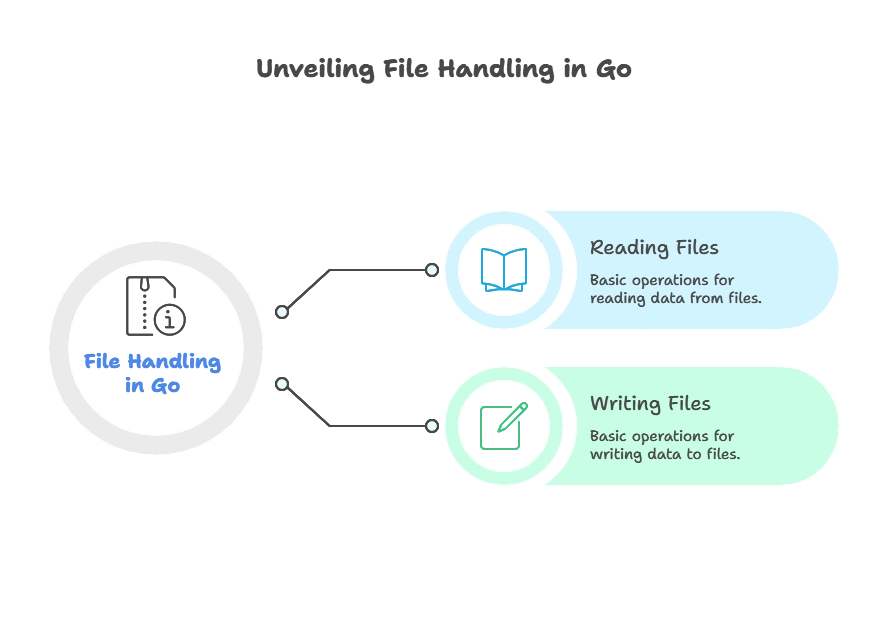Reading and Writing Files in Go
File handling is a crucial aspect of programming, allowing us to interact with external data sources such as text files, databases, and network resources. In Go, reading and writing files is straightforward, thanks to its powerful standard library.
Basics of File Operations

In this section, we’ll cover the fundamental operations of reading from and writing to files in Go.
Reading from Files
To read from a file in Go, we typically follow these steps:
Step 1: Open the file using os.Open() or os.OpenFile().
Step 2: Read data from the file using various methods like Read(), ReadAll(), or Scanner.
Step 3: Close the file to release system resources using defer or explicitly with Close().
package main
import (
"fmt"
"os"
"io/ioutil"
)
func main() {
file, err := os.Open("example.txt")
if err != nil {
fmt.Println("Error:", err)
return
}
defer file.Close()
data, err := ioutil.ReadAll(file)
if err != nil {
fmt.Println("Error:", err)
return
}
fmt.Println("File content:", string(data))
}
- We open the file “example.txt” using
os.Open(). - Then, we read all data from the file using
ioutil.ReadAll(). - Finally, we print the content of the file to the console.
Writing to Files
To write to a file in Go, we typically follow these steps:
Step 1: Create or open the file using os.Create() or os.OpenFile().
Step 2: Write data to the file using methods like Write(), WriteString(), or Writer.
Step 3: Close the file to save changes and release system resources
package main
import (
"fmt"
"os"
)
func main() {
file, err := os.Create("output.txt")
if err != nil {
fmt.Println("Error:", err)
return
}
defer file.Close()
_, err = file.WriteString("Hello, World!")
if err != nil {
fmt.Println("Error:", err)
return
}
fmt.Println("Data written to file successfully")
}
- We create a new file “output.txt” using
os.Create(). - Then, we write the string “Hello, World!” to the file using
file.WriteString(). - Finally, we print a success message indicating that the data has been written to the file.
Advanced File Operations
In this section, we’ll explore advanced techniques for file handling in Go, including working with file permissions, buffered IO, and concurrent file operations.
Buffered IO
Buffered IO operations can improve performance by reducing the number of system calls made for reading and writing data.
package main
import (
"fmt"
"os"
"bufio"
)
func main() {
file, err := os.Open("example.txt")
if err != nil {
fmt.Println("Error:", err)
return
}
defer file.Close()
scanner := bufio.NewScanner(file)
for scanner.Scan() {
fmt.Println(scanner.Text())
}
if err := scanner.Err(); err != nil {
fmt.Println("Error:", err)
return
}
}
- We open the file “example.txt” using
os.Open(). - Then, we use
bufio.Scannerto read data from the file line by line efficiently. - Each line of the file is printed to the console.
In this chapter, we've covered the essentials of reading from and writing to files in Go, starting from basic operations to more advanced techniques. Understanding file handling is essential for building robust applications that interact with external data sources. By mastering these concepts and exploring further, you'll be well-equipped to handle file IO tasks effectively in your Go programs. Practice, experimentation, and continued learning are key to becoming proficient in this aspect of Go programming. Happy coding !❤️
